Robotic Vehicles Enable High-Resolution Light Pollution Sampling of Sea Turtle Nesting Beaches
- 1Division of Marine Science and Conservation, Nicholas School of the Environment, Duke University Marine Laboratory, Beaufort, NC, United States
- 2Department of Electrical and Computer Engineering, North Carolina State University, Raleigh, NC, United States
Nesting sea turtles appear to avoid brightly lit beaches and often turn back to sea prematurely when exposed to artificial light. Observations and experiments have noted that nesting turtles prefer darker areas where buildings and high dunes act as light barriers. As a result, sea turtles often nest on darker beaches, creating spatial concentrations of nests. Artificial nighttime light, or light pollution, has been quantified using a variety of methods. However, it has proven challenging to make accurate measurements of ambient light at fine scales and on smaller nesting beaches. Additionally, light has traditionally been measured from stationary tripods perpendicular to beach vegetation, disregarding the point of view of a nesting sea turtle. In the present study, nighttime ambient light conditions were assessed on three beaches in central North Carolina: a developed coastline of a barrier island, a nearby State Park on the same barrier island comprised of protected and undeveloped land, and a completely uninhabited wilderness on an adjacent barrier island in the Cape Lookout National Seashore. Using an autonomous terrestrial rover, high resolution light measurements (mag/arcsec2) were collected every minute with two ambient light sensors along transects on each beach. Spatial comparisons between ambient light and nesting density at and between these locations reveal that highest densities of nests occur in regions with lowest light levels, supporting the hypothesis that light pollution from coastal development may influence turtle nesting distribution. These results can be used to support ongoing management strategies to mitigate this pressing conservation issue.
Introduction
All six species of sea turtles found in waters in the United States are listed as threatened or endangered by the US Endangered Species Act of 1973 (Witherington et al., 2014). Therefore, protection of nesting habitat is crucial to ensure these species can recover. Nest site selection is influenced by many environmental factors including sand characteristics, wave energy, terrestrial predation, and nearby oceanic currents (Donlan et al., 2010; Kelly et al., 2017). Nesting sea turtles also face a number of anthropogenic threats such as bycatch in fisheries, interaction with marine debris, and habitat degradation from coastal development, which have all contributed to a global sea turtle population decline (Donlan et al., 2010). Light pollution, often in the form of excessive artificial light from coastal development, is considered amongst the most serious anthropogenic threats due to rapidly expanding coastal development (Witherington, 1997; Salmon, 2003). All United States sea turtle species nest primarily at night and many are exposed to sources of artificial light on nesting beaches (Witherington, 1997). Managing light pollution is crucial for sea turtle population recovery and will help guide and target conservation efforts (Kamrowski et al., 2012).
In areas of light pollution, nesting sea turtles can experience disorientation from direct glare or may be repelled from or attracted to bright lights (Longcore and Rich, 2004). Female sea turtles are known to avoid brightly lit beaches in favor of dark beaches with background vegetation, no artificial light, and minimal human activity (Worth and Smith, 1976; Witherington, 1992; Salmon et al., 1995). Past studies have demonstrated that sea turtles prefer to nest where light pollution is blocked by structures that act as ‘light barriers’ such as buildings or tall dunes, indicating that beach geomorphology and structures may alter the amount of light a nesting sea turtle is exposed to Salmon et al. (1995). Light pollution can disrupt nest-site selection leading to detrimental nesting behavior such as nest abandonment, abbreviation, and the disruption of sea-finding (Witherington et al., 2014). In some cases, light pollution can affect egg-laying behavior of female sea turtles, causing them to turn back to the ocean prematurely and failing to nest (Witherington et al., 2014). As such, light pollution can constrain the extent of nesting habitat for sea turtles, contributing to a form of habitat loss (Witherington et al., 2014). As artificial light deters sea turtles from nesting sites, sea turtles may select suboptimal nesting sites or cluster their nests on darker beaches subject to other threats (Witherington, 1992). This can lead to the destruction of previously deposited nests, increased probability of nest washouts, and greater interactions with terrestrial predators (Salmon, 2003).
Light pollution also appears to impact hatchling sea turtles; the effects of which may not be evident until decades later when the females come back to the beach to nest. Light pollution has been known to cause thousands of hatchling deaths per year in Florida (Salmon, 2003). Experimental lab and field studies have concluded that hatchlings orient to the brightest light on a beach (Salmon et al., 1995; Tuxbury and Salmon, 2005). Disoriented hatchlings can exhaust energy stores while spending additional time trying to find the ocean (Pankaew and Milton, 2018). Some hatchlings never do find the water at all, getting lost in dunes or getting run over by cars (Salmon, 2003). Hatchlings still on the beach during daylight risk death from dehydration and predation (Pankaew and Milton, 2018). Most sea turtle organizations on developed beaches in United States east coast nesting states have some type of management in place to protect hatchlings from surrounding light. Monitoring of disorientation and documenting mortality rates can help identify specific lights that continue to be problematic to sea turtle hatchlings.
Light pollution has been quantified using various technologies throughout the years, although discrepancies amongst the methods have led to a lack of comparable light measurements for sea turtle nesting conservation plans and management. Instruments such as wide-field charge-coupled device (CCD) camera systems can be used to accurately measure brightness of a night sky by stitching together images taken from a robotic mount to form a mosaic of an entire sky (Duriscoe et al., 2007; Pendoley et al., 2012). Researchers have also used handheld or tripod mounted stellar photometers and light meters to study how nighttime light affects sea turtle behavior (Salmon et al., 1992, 1995; Salmon and Witherington, 1995; Bertolotti and Salmon, 2005; Sella et al., 2006; Kamrowski et al., 2015). Researchers have mounted light meters on small tripods aimed at the horizon to collect relative light radiance in various directions (Salmon and Witherington, 1995). Sky Quality Meters (SQM, Unihedron) measure light with wavelengths in the range adult sea turtles are known to respond to and have been used to assess impacts of light pollution on sea turtle nesting behavior; proving to be an accessible, affordable, and accurate tool to measure nighttime sky brightness (Levenson et al., 2004; Bonner, 2015; Constant, 2015; Kelly et al., 2017). SQMs have conventionally collected nighttime light on stationary tripods across dune transects or perpendicular to the dune in specific increments along the beach (Bonner, 2015; Constant, 2015).
Studies have also utilized satellite-based remote sensing to assess broad scale effects of light pollution on nesting patterns of sea turtles (Kamrowski et al., 2012; Mazor et al., 2013; Brei et al., 2016; Weishampel et al., 2016). Satellite data have been used to compare amounts of light to nesting density on individual nesting beaches; however, satellite pixel size is often much coarser than the width of most nesting beaches and can be subject to cloud cover and moon phase (Kamrowski et al., 2012). The resolution of satellite light data can lead to the integration of light sources not directly on the beach or light that could potentially be shaded by vegetation, buildings, or high dunes that nesting sea turtles would not experience (Weishampel et al., 2016). Beachfront lighting in an undeveloped area can also be disregarded in satellite data but could have a significant potential to disrupt local sea turtle nesting (Kamrowski et al., 2012).
The advent of small durable microelectronics, 3D printers, open source hardware designs, and software packages has resulted in a vibrant small robotics community with a growing set of environmental applications. Autonomous rovers have been widely used for planetary exploration and are gaining popularity in other applications such as polar science remote sensing and soil assessments (Lacroix et al., 2002; Ray et al., 2014; Piper et al., 2015). Autonomous sampling approaches such as the low-cost rover employed in this study can increase the resolution, reduce costs of sampling, and in some cases, reduce the effects of human disturbance on environmental sampling.
For the present study, nighttime ambient light levels light pollution were measured on three adjacent beaches on the central North Carolina coast to assess impacts on sea turtle nesting density. The methods used here build upon previous studies by sampling high resolution light levels continuously at a sea turtle’s eye-level with regards to beach topography and produce an encompassing representation of surrounding nighttime light a nesting sea turtle would encounter when crawling onshore to nest. This novel method can repeatedly sample light to assist in making sound coastal management decisions about light pollution limitations.
Materials and Methods
Study Area
Light pollution data were collected on moonless nights between astronomical dusk and dawn in summer 2017 on three adjacent beaches in central North Carolina (Figure 1). Atlantic Beach is a 10,000 m developed coastline situated on a barrier island bordered by the Atlantic Ocean and Bogue Sound interspersed with private homes and businesses. Fort Macon State Park located on the eastern end of the same barrier island is a 1,600 m stretch of beach comprised of protected and undeveloped land. Shackleford Banks, an adjacent barrier island in the Cape Lookout National Seashore spans roughly 13,000 m of completely uninhabited wilderness. All three beaches support sea turtle nesting during the months of May through October, primarily of loggerheads (Caretta caretta), with lower numbers of greens (Chelonia mydas), leatherbacks (Dermochelys coriacea), and Kemp’s Ridleys (Lepidochelys kempii)1.
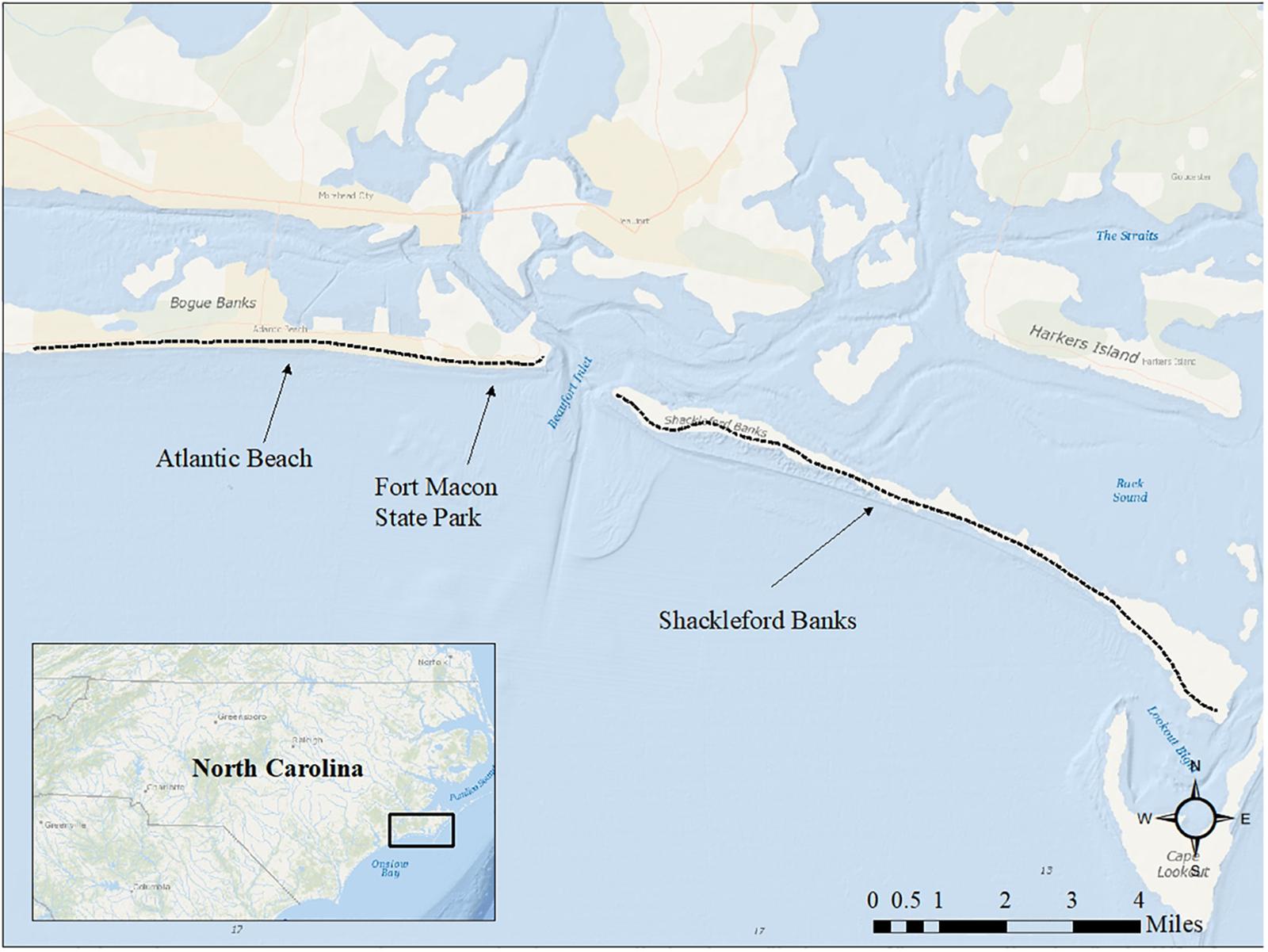
Figure 1. Map of study area: Atlantic Beach, Fort Macon State Park, and Shackleford Banks, NC, United States. Dashed lines represent autonomous terrestrial rover deployments during summer 2017.
Data Collection
Two ambient light sensors (Sky Quality Meter-LU-DL, Unihedron) were mounted on an autonomous terrestrial rover (Figure 2): one facing forward, one facing the beach. The chassis of the rover platform was derived from a commercially available radio-control (RC) car kit and enhanced with four-wheel drive and steering capabilities, and a ruggedized suspension. The rover was autonomously piloted by an open source Pixhawk autopilot2 loaded with the latest APM: Rover software3. Mission Planner, an open source software program4 was used to set the route and velocity of the rover during sampling. The rover was guided using onboard GPS and progress was constantly tracked through standard UHF telemetry. The rover deployed from coordinates 34.69°N, -76.67°W on Fort Macon to 34.69°N, -76.78°W on Atlantic Beach and from 34.63°N, -76.53°W to 34.69°N, -76.65°W on Shackleford Banks (Figure 1). The cost of rover parts, including light sensors was approximately $1000.00 USD.
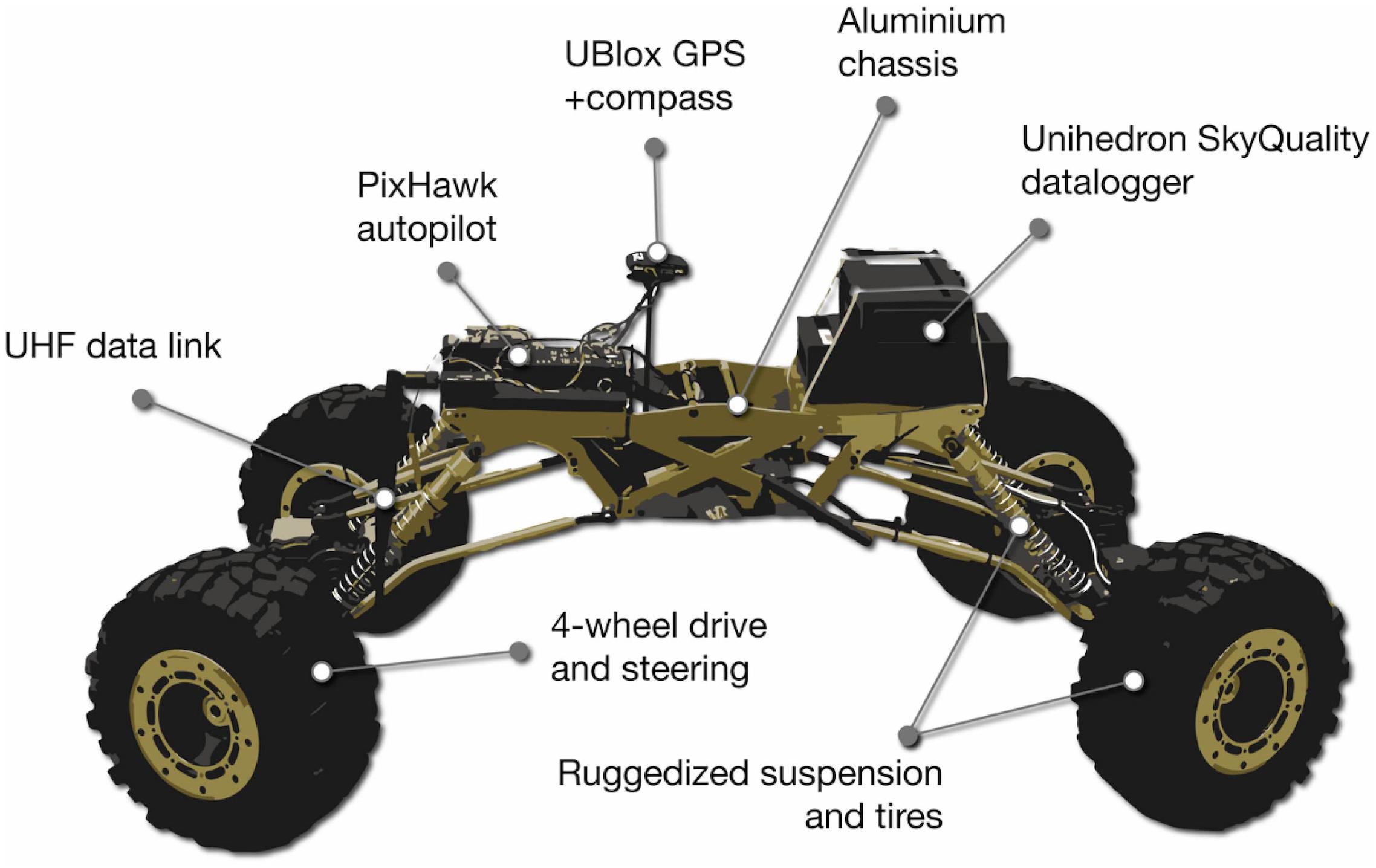
Figure 2. Autonomous terrestrial rover platform (84 cm × 43.6 cm × 35 cm) equipped with continuously datalogging Unihedron Sky Quality Meters. Command and control components indicated.
Sky quality meters (SQM-LU-DL) are portable light meters that measure visible light in magnitudes per square arc second (mag/arcsec2) over a 20-degree arc5 (Birriel and Adkins, 2010). ‘Magnitudes per square arc second’ is an astronomical term describing brightness in magnitudes spread out over a square arc second of the sky. Lower values indicate high light pollution. A decrease in magnitude (numerically), corresponds with approximately 2.5 times more ambient light from a given light reading5 . The SQMs were programmed to record ambient light every minute while an onboard GPS recorded geographic coordinates of the rover path.
Biologists, park rangers, and volunteers trained through North Carolina Wildlife Resources Commission’s Division of Wildlife Management monitor the state’s sea turtle population. Date, location, and species (if available) of all species of sea turtles found nesting between May through August for all three beaches during 2011–2017 were provided by respective sea turtle beach coordinators. During this time period, a total of 37 nests were verified on Atlantic Beach, 28 were verified on Fort Macon, and 160 were verified on Shackleford Banks. Nest date and geographic coordinates were collected for each nest verified on each beach.
Data Analyses
To assess differences of light pollution amongst nesting locations, each sea turtle nest location was linked to the closest light pollution value by using a spatial join tool on GIS, producing a table listing every nest with a corresponding light value. The average distance from nest to closest light pollution values was approximately 10 m. Ambient light measurements at each nesting location were assessed using a one-way analysis of variance (ANOVA) and a non-parametric Wilcoxon Each Pair test to assess differences in mean ambient light levels from each beach location.
Light pollution and nesting density data were aggregated into 500-m along-shore bins to assess the spatial relationships of these data. Mean light pollution (mag/arcsec2) and nesting density (nests/year) were calculated for each bin. The number of verified nests and light pollution measurements recorded in 500-m increments were considered sufficient data for comparison of light measurements and nesting density. A linear regression analysis was conducted to study the relationship between mean light and nesting density within each 500-m bin (JMP statistical software). Due to an uneven spatial distribution of nesting density, the Spatial Statistics toolbox in ArcMap (ESRI) was used to analyze spatial distributions and patterns of light pollution and nesting. A Global Moran’s I Spatial Autocorrelation test using a Euclidian inverse distance weight was employed to evaluate whether nesting density exhibited significant clustering on each beach. Anselin Local Moran’s I Cluster and Outlier Analysis tests were then run on these data to display where nesting density and light pollution were significantly high and low with regards to neighboring data.
Results
The rover easily navigated each beach transect without human interaction, illustrating that autonomous surveys in these locations can be accomplished rapidly and repeatedly. A total of 129 light measurements were made every minute at Atlantic Beach, 38 at Fort Macon State Park, and 234 at Shackleford Banks. Initial comparisons between forward facing and beach-facing SQMs revealed similar results, and as such analyses were conducted on beach-facing as it best represents the view experienced by an emerging sea turtle.
Variability Across Beach Locations
This study found varying nesting densities on the three study beaches. The least amount of light pollution was found on Shackleford Banks (21.35 mag/arcsec2, dark) while the greatest amount of light pollution was found on Atlantic Beach (10.13 mag/arcsec2, bright) (Figure 3). The results of the ANOVA and non-parametric multiple comparisons demonstrate that light pollution levels at nests on the three study sites were significantly different, indicating that nesting sea turtles are experiencing significantly different light pollution levels across the three different beaches (Table 2 and Figure 4). Average light pollution on Atlantic Beach was 8 times brighter than the average light pollution on Fort Macon State Park, and 36 times brighter than Shackleford Banks.
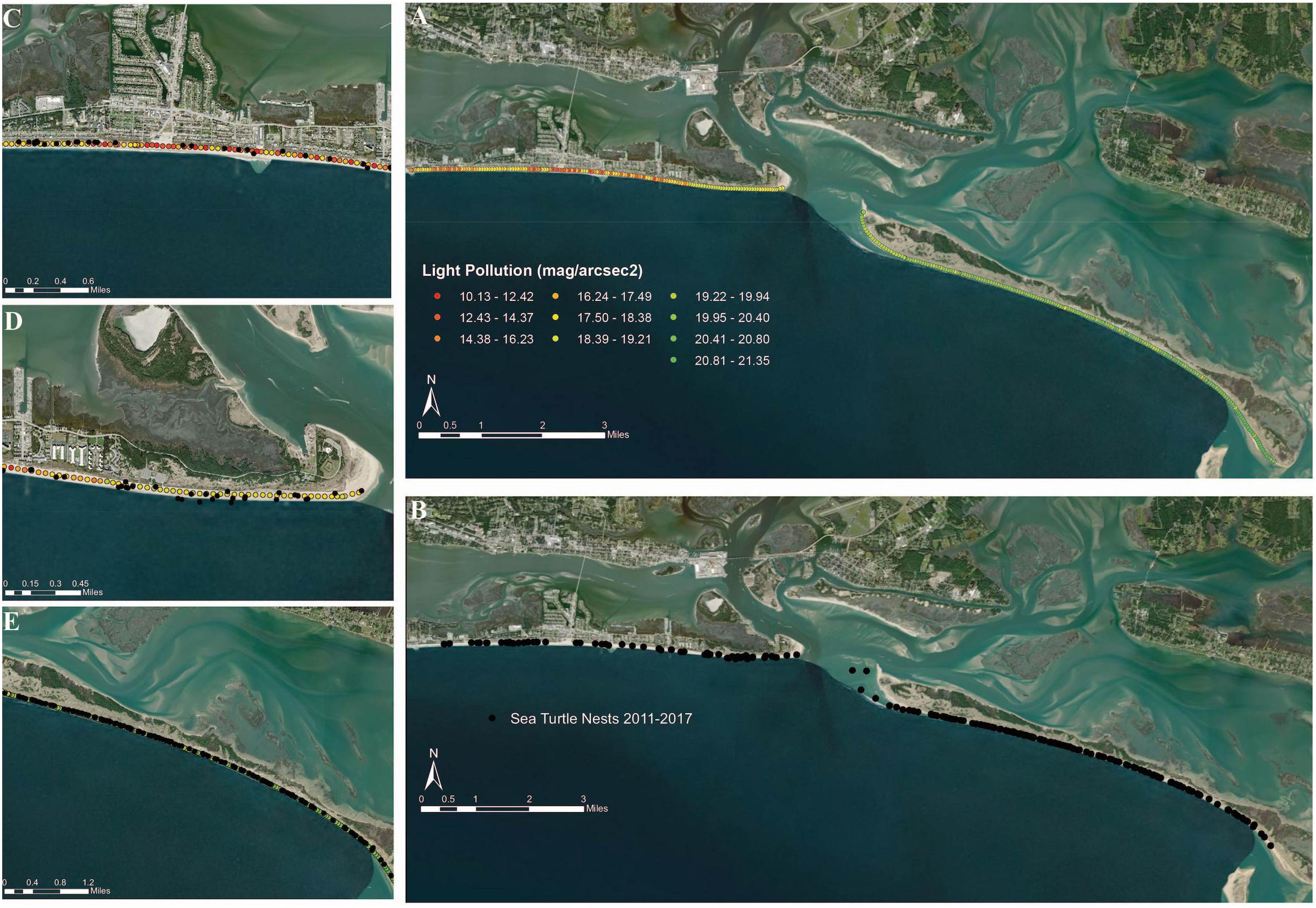
Figure 3. (A) Light pollution values (mag/arcsec2) taken every minute on autonomous terrestrial rover on study sites in summer 2017. Low mag/arcsec2 values indicate high light pollution. (B) Verified nest locations on study sites from 2011 to 2017. (C–E) Enlarged map insets illustrating the increase of total nesting density (nests/year) from 2011 to 2017 as light pollution levels increase on (C) Atlantic Beach, (D) Fort Macon State Park, and (E) Shackleford Banks. Black dots represent 2011–2017 sea turtle nests overlaid on color dots representing light.
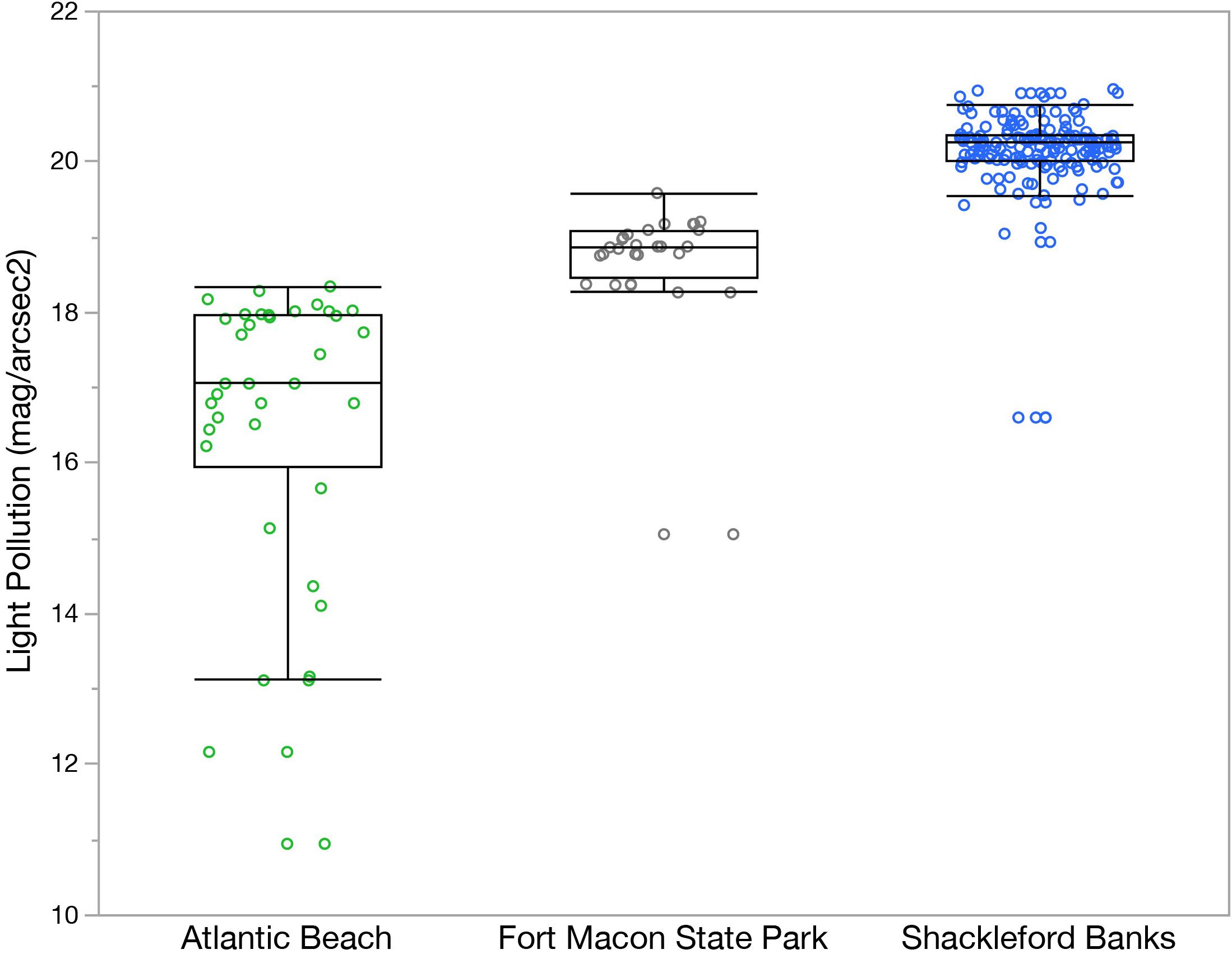
Figure 4. Significantly different mean (+/- SD) light pollution values (mag/arcsec2) at each nest location at Atlantic Beach, Fort Macon State Park, and Shackleford Banks, NC (One-Way ANOVA, p < 0.0001). Dots represent light pollution value at each nest.
Nesting Density and Light Pollution
Nesting density on all three beaches varied from 0 to 5.33 (Table 1). Shackleford Banks had the highest average nesting density (2.80 ± 0.97 nests/year/length) and lowest average light pollution (20.23 ± 0.60 mag/arcsec2), and Atlantic Beach had the lowest nesting density (1.19 ± 0.85 nests/year/length) and highest average light pollution (16.29 ± 2.21 mag/arcsec2) (Table 1). Solely through observation, it is apparent that nests were sparser in areas of high light pollution on Atlantic Beach, were relatively more abundant on Fort Macon State Park, and considerably more clustered on Shackleford Banks (Figure 3).

Table 1. Sample size (N), average, minimum, maximum, and SD of light pollution (mag/arcsec2) and nesting density (nests/year/beach length) on Atlantic Beach, Fort Macon State Park, and Shackleford Banks, NC. Low mag/arcsec2 values indicate high light pollution.
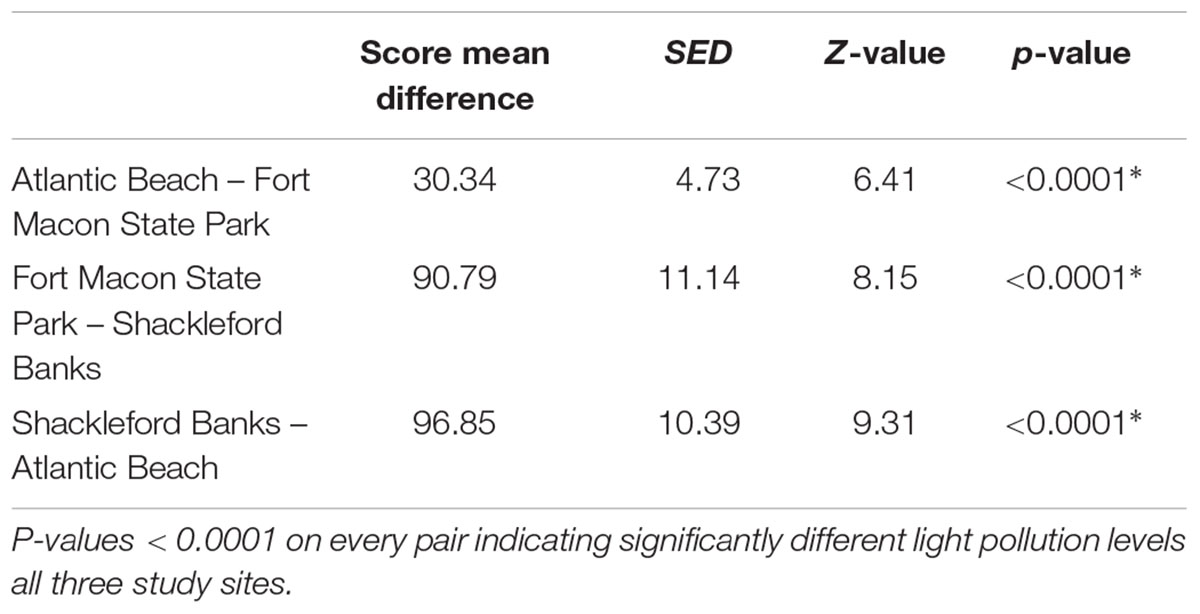
Table 2. Non-parametric multiple comparisons of closest light pollution level (mag/arcsec2) at nests located on each study site using Wilcoxon test on each pair.
When aggregating light pollution measurements and nesting density by 500-m increments, direct comparisons of the amount of light and the number of nests were made. Mean light pollution values in all bins ranged from 13.56 to 20.95 mag/arcsec2 (Figure 5). Nesting density from 2011 to 2017 ranged from 0 to 1.86 nests/year in all bins (Figure 5). Visual observations demonstrate lower nesting density in regions along Atlantic Beach corresponding to regions of high light pollution, and high nesting density in regions along Shackleford Banks corresponding to regions of low light pollution (Figure 5).
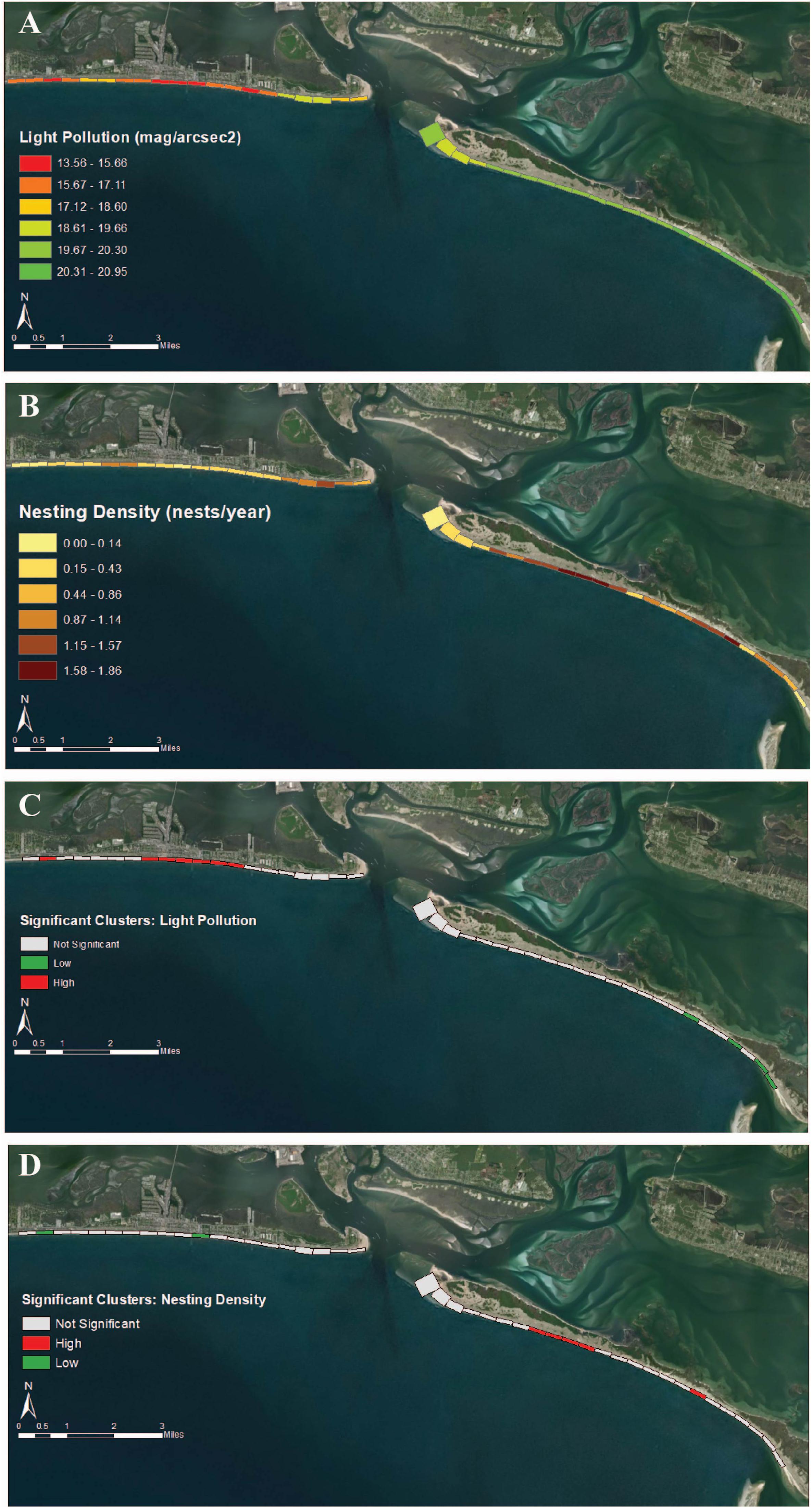
Figure 5. (A) Mean light pollution value (mag/arcsec2) in 500-m bins along study sites. (B) Nesting density (nests/year) from 2011 to 2017 in 500-m bin along study sites. (C) Cluster and Outlier Analysis (Anselin Moran’s I) portraying regions of significantly high light pollution in red and low light pollution in green and (D) significantly high nesting density in red and low nesting density in green.
Mean light pollution and nesting density per 500-m bin were significantly correlated, with lower nesting density corresponding to locations of high light pollution (n = 44, R2 = 0.28, p = 0.0002, Figure 6). On Shackleford Banks, nesting density ranged in areas from low to high light pollution, with low nesting density potentially occurring due to environmental factors. On Atlantic Beach, nesting density occurs primarily in areas of high light pollution indicating a strong threat of light on nests laid on this beach.
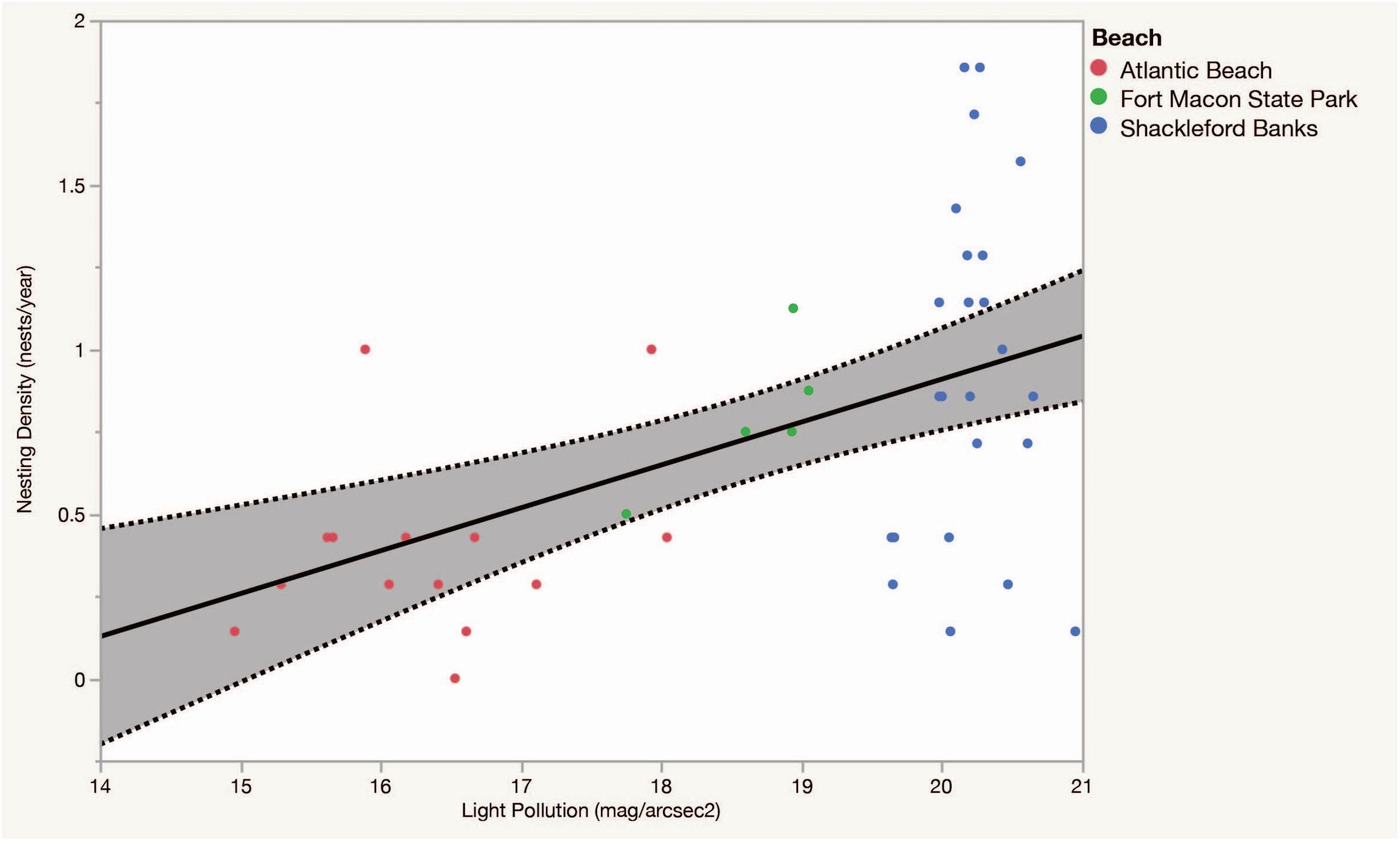
Figure 6. Linear regression (n = 44, R2 = 0.28, p = 0.0002) of nesting density (nests/year) and light pollution (mag/arcsec2) per 500-m bin on Atlantic Beach, Fort Macon State Park, and Shackleford Banks, NC sampled during the summer of 2017. Line of best fit: nesting density = –1.70 + 0.13 ∗ light pollution. Dashed lines represent 95% confidence interval for mean nesting density for a given value of light pollution.
The Moran’s I spatial autocorrelation conducted on nesting density revealed a significant 0.629 global statistic from 999 random permutations, demonstrating high clustering of nests in the study area (p = 0.00001). The Anselin Local Moran’s I test conducted on light pollution levels exhibits regions of statistically significant high light pollution clusters (p < 0.05, Figure 5) on Atlantic Beach and significantly low light pollution clusters (p < 0.05, Figure 5) on Shackleford Banks. The Anselin Local Moran’s I test identifies regions of statistically significant high nesting density on Shackleford Banks and significant low nesting density on Atlantic Beach (p-value < 0.05, Figure 5). The regions of low nesting density were located in areas of high coastal development, such as in front of a brightly lit pier on Atlantic Beach and near a waterfront hotel. All significantly high light pollution levels on Atlantic Beach correspond to low nesting density, supporting the hypothesis that light pollution may influence sea turtle nesting density (Figure 5).
Discussion
In this study, sea turtle nesting was less dense in areas of high light pollution compared to areas of low light pollution. There was a significant relationship between nesting density and light pollution levels, with more nests occurring in regions of darker beach. The novel light collection method employed in this study using an autonomous terrestrial rover accurately illustrates where problematic light pollution exists. Results from this study suggest that management action targeting bright areas near a pier and in front of a waterfront hotel where light is bright and nesting density is low or absent may benefit nesting turtles. This type of precision data collection can assist beach management in prioritizing locations for conservation action.
Using an autonomous terrestrial rover to collect light data is a more consistent method of data collection because it reduces human error. It is also safer to use than traditional sampling techniques and can be used in places hard to access by foot. Since the rover is approximately the size and height of a nesting female sea turtle, it collects the data necessary to make accurate estimates of where light pollution is most harmful to nesting sea turtles. Light was collected on the moving rover traveling over topographical features across a beach landscape, mimicking the crawling movements of a nesting sea turtle. High resolution light measurements take beach topographical features into account, providing additional information on the amount of light a nesting sea turtle encounters while nesting.
Variability Across Beach Locations
The beach study sites consist of a developed public beach, a state park, and a national seashore. Each location is managed differently with varying objectives, and nesting density differs on each beach. The Cape Lookout National Seashore works to protect, maintain and restore dark night sky environments6. National Parks and Seashores could be considered as refuges for species that rely on darkness for breeding and feeding patterns (Manning et al., 2015). The lack of development on Shackleford Banks and the National Seashore’s dark skies initiative may both contribute to the abundance of sea turtle nesting activity.
As a North Carolina state park, Fort Macon strives to conserve and protect the state’s natural beauty, ecological features and cultural resources7. Since housing and business development is not permitted, they too can become dark night refuges for nocturnal species. Fort Macon State Park has a considerably higher density of sea turtle nests than on Atlantic Beach, supporting to the hypothesis that sea turtles prefer to nest on dark beaches (Witherington and Martin, 2003). Atlantic Beach has no consistent waterfront light management and contains substantially brighter areas along the beach. While some sea turtles still choose to nest on this beach, there are significant gaps in nesting, and the beach has a considerably lower nesting density overall than the adjacent barrier island of Shackleford Banks.
Advancements in Low-Cost Autonomous Robotics
While the affordable autonomous terrestrial rover described in this study is suitable for sampling ambient light conditions in uncluttered beach and coastal environments, it can be tailored with other sensors to measure environmental and anthropogenic factors such as temperature, motion, noise, dune vegetation, and more. These variables can provide additional data on what nesting sea turtles might encounter that could potentially impact the success of nesting and hatching, providing valuable information on how to properly manage nesting areas. Future iterations of the rover platform can include real-time sense and avoid functionality to reduce interactions with obstacles and wildlife. Technological advancements in battery life and GPS functionality can also improve autonomy and accessibility.
Caveats and Considerations
A variety of anthropogenic variables such as noise and human activity can also significantly influence nesting trends. For example, the collected data suggest that bright lights associated with hotels impact nesting; however, hotels also increase the probability of nesting activity being disturbed by tourists. Studies have shown that the presence of people moving within the field of view of a nesting turtle can cause nest abandonment just as often as lighting (Witherington et al., 2014). Research on other anthropogenic variables in addition to light that may influence a sea turtle’s decision to nest should be incorporated in future studies (Mazor et al., 2013; Weishampel et al., 2016; Kelly et al., 2017) and more nuanced multivariate analyses of nesting characteristics can provide a more holistic understanding of what effects nesting activity. Ongoing coastal development can also result in changes in relationships of nesting data and light. The methods described in the present study provide for high replicability, presenting opportunities to assess changes in light data over time.
Environmental factors can also influence nesting such as sand characteristics, spatial orientation of land, temperatures, currents, etc. (Mortimer, 1990; Best, 2017). In order to properly manage light pollution on sea turtle nesting beaches, areas where anthropogenic and environmental impacts are most significant need to be accurately identified and managed. Further investigation is warranted to provide explanations as to why nesting turtles are avoiding certain areas of a nesting beach year after year.
The use of robotic vehicles to collect scientific data presents some challenges. While all the parts for the rover are commercially available and supported with open source software, assembling the rover requires some knowledge of electronics and battery technology. As with all technology, potential problems can occur with the rover or sensors in the field, disrupting consistent data collection. Although the rover collected high resolution light pollution measurements, spatial comparisons to nesting density were done in 500-m increments. Under higher nesting density conditions, direct comparisons could have been done at a smaller scale, providing more detailed results of where light pollution was impacting nesting activity.
Additionally, the type of light sensor used in this study a limited field of view, which may not completely capture the perspective of a sea turtle as it emerges from the ocean. While the movement of the platform addresses this limitation in part (it essential scans the beach as it moves along), a light sensor with a wider field of view or a planar irradiance sensor would produce a more refined light pollution perspective.
Future Research and Management Implications
Of all of the anthropogenic variables threatening sea turtle populations, light is arguably one of the most manageable (Witherington and Martin, 2003). Light serves an undeniably important feature for homes and businesses. Homeowners may choose to keep exterior and interior lights on to prevent burglaries, and businesses such as restaurants and hotels perceive light as an efficient technique to attract customers and guests. Coastal town management utilizes lights in parking lots and public beach access sites for the safety and satisfaction of vacationing tourists.
With proper light management, artificial light does not need to be completely prohibited. Light sources can meet the needs of humans while minimizing the disruption of nesting sea turtle behavior. Techniques can reduce the intensity of artificial light such as lowering the wattage of lights, focusing a light source toward the ground, and implementing light barriers to shield direct light sources (Witherington, 1997). Technological advances such as motion detector switches and timers can also be utilized to lessen the effects of light pollution on nesting beaches. Those responsible for harmful light sources are usually unaware of the detrimental effects to nesting sea turtles (Witherington et al., 2014). Simple educational measures such as informational material or public signs could prove useful tactics to reduce the amount of light occurring on a beach at night.
Viewshed analysis, a geographic information system (GIS) approach, has been used to estimate light pollution impacts on a beach landscape (Verutes et al., 2014). Line of sight calculations are computed from a viewer’s location to a pixel on a landscape, representing an area that can receive direct light. When a viewshed approach is coupled with a high-resolution digital elevation model, locations of buildings, vegetation, and dunes can more accurately model how features can block the path of anthropogenic light (Verutes et al., 2014). Technological advancements in the use of unmanned aircraft systems (UAS) can produce highly accurate digital elevation models derived from Structure-from-Motion (SfM) photogrammetry and aerial LiDAR (Seymour et al., 2018; Johnston, 2019). These models can accurately extract environmental and topographical features of a shoreline such as beach slope, locations of buildings, vegetation, and escarpments that can influence nest site selection (Kelly et al., 2017). By coupling drone-based high resolution digital elevation models with high resolution light pollution measurements, this method could accurately estimate where topographical features obstruct the path of anthropogenic light, and which individual lights are most problematic, providing the information needed for well-targeted management policies (Weishampel et al., 2016). High resolution light pollution data collected from an autonomous terrestrial rover could also be used to ground-truth future satellite data studies. This will improve future research on expansive light pollution studies, allowing researchers to more confidently use satellite imagery to assess light pollution arising form coastal development.
Conclusion
This study illustrates the potential of using an autonomous terrestrial rover to efficiently quantify light pollution in coastal habitats. Elevated light pollution levels were positively correlated with low nesting density, supporting the hypothesis that coastal development leads to a concentration of nests in a decreasing area of dark beaches (Salmon, 2003). The high spatial resolution of collected data also reveal specific areas where light management could contribute positively to nesting beach quality. This pilot study can be easily replicated elsewhere to assist town and beach managers to make informed decisions on how to properly manage artificial light to protect nesting sea turtles. If properly developed and implemented, light sources can meet the needs of humans while decreasing the harmful impact on nesting sea turtle behavior.
Data Availability Statement
The raw data supporting the conclusion of this manuscript will be made available by the authors, without undue reservation, to any qualified researcher.
Ethics Statement
All surveys were conducted under permit by Cape Lookout National Seashore and North Carolina Department of Natural and Cultural Resources.
Author Contributions
All authors contributed to the development, planning, and data collection of the study. AW and DJ contributed to data analysis, interpretation, and writing of the manuscript.
Funding
AW was funded by the Edna Bailey Sussman Foundation. Rover and parts were funded by the Duke University Marine Lab.
Conflict of Interest Statement
The authors declare that the research was conducted in the absence of any commercial or financial relationships that could be construed as a potential conflict of interest.
Acknowledgments
We thank the sea turtle coordinators on Atlantic Beach, Fort Macon State Park, and Shackleford Banks for past sea turtle nesting records and allowing us to collect light pollution data. Thank you to Rett Newton and Julian Dale from the Marine Robotics and Remote Sensing Lab for help with the design and engineering of the rover platform. Also, thank you Candice Sheehan, Julian Race, and Sarah Norris for assisting in data collection.
Footnotes
- ^North Carolina Wildlife Resources Commission. 2005. Sea Turtle. Retrieved online at https://www.ncwildlife.org/Portals/0/Conserving/documents/FactSheets/nongame_seaturtle_hires.pdf
- ^Pixhawk Products. 2018. Retrieved online at https://pixhawk.org
- ^Rover Home. 2016. Retrieved online at http://ardupilot.org/rover/
- ^Mission Planner Home. 2016. Retrieved online at http://ardupilot.org/planner/
- ^Sky Quality Meter-LU-DL. Unihedron, Retrieved online at http://www.unihedron.com/projects/sqm-lu-dl/
- ^National Park Service. Natural Sounds and Night Skies Division. Retrieved online at https://www.nps.gov/orgs/1050/whatwedo.htm
- ^North Carolina State Parks. Retrieved online at https://www.ncparks.gov
References
Bertolotti, L., and Salmon, M. (2005). Do embedded roadway lights protect sea turtles? Environ. Manage. 36, 702–710.
Best, Z. E. (2017). Environmental Factors Affecting Loggerhead Sea Turtle (Caretta caretta) Nesting, Hatching, and Incubation Patterns in Broward County, Florida. Master’s thesis, Nova Southeastern University, Fort Lauderdale.
Birriel, J., and Adkins, J. K. (2010). A simple, portable apparatus to measure night sky brightness at various zenith angles. J. Am. Assoc. Var. Star Observ. 38, 221–229.
Bonner, R. (2015). The Impact of Photopollution on Nesting Loggerhead Sea Turtles (Caretta caretta) along the Grand Strand, South Carolina. Doctoral dissertation, Coastal Carolina University, Conway, SC.
Brei, M., Pérez-Barahona, A., and Strobl, E. (2016). Environmental pollution and biodiversity: light pollution and sea turtles in the Caribbean. J. Environ. Econ. Manage. 77, 95–116. doi: 10.1016/j.jeem.2016.02.003
Constant, N. (2015). Geospatial Assessment of Artificial Lighting Impacts on Sea Turtles in Tortuguero, Costa Rica. Master’s thesis, Duke University, Durham.
Donlan, C. J., Wingfield, D. K., Crowder, L. B., and Wilcox, C. (2010). Using expert opinion surveys to rank threats to endangered species: a case study with sea turtles. Conserv. Biol. 24, 1586–1595. doi: 10.1111/j.1523-1739.2010.01541.x
Duriscoe, D. M., Luginbuhl, C. B., and Moore, C. A. (2007). Measuring night-sky brightness with a wide-field CCD camera. Publ. Astron. Soc. Pac. 119:192. doi: 10.1086/512069
Kamrowski, R. L., Limpus, C., Moloney, J., and Hamann, M. (2012). Coastal light pollution and marine turtles: assessing the magnitude of the problem. Endangered Species Res. 19, 85–98. doi: 10.3354/esr00462
Kamrowski, R. L., Limpus, C., Pendoley, K., and Hamann, M. (2015). Influence of industrial light pollution on the sea-finding behaviour of flatback turtle hatchlings. Wildl. Res. 41, 421–434. doi: 10.1071/WR14155
Kelly, I., Leon, J. X., Gilby, B. L., Olds, A. D., and Schlacher, T. A. (2017). Marine turtles are not fussy nesters: a novel test of small-scale nest site selection using structure from motion beach terrain information. PeerJ 5:e2770. doi: 10.7717/peerj.2770
Johnston, D. W. (2019). Unoccupied Aircraft Systems in Marine Science and Conservation. Ann. Rev. Mar. Sci. 11, 9.1–9.25. doi: 10.1146/annurev-marine-010318-095323
Lacroix, S., Mallet, A., Bonnafous, D., Bauzil, G., Fleury, S., Herrb, M., et al. (2002). Autonomous rover navigation on unknown terrains: functions and integration. Int. J. Robot. Res. 21, 917–942. doi: 10.1177/0278364902021010841
Levenson, D. H., Eckert, S. A., Crognale, M. A., Deegan, J. F., and Jacobs, G. H. (2004). Photopic spectral sensitivity of green and loggerhead sea turtles. Copeia 2004, 908–914. doi: 10.1643/CP-03-217R1
Longcore, T., and Rich, C. (2004). Ecological light pollution. Front. Ecol. Environ. 2, 191–198. doi: 10.2307/3868314
Manning, R., Rovelstad, E., Moore, C., Hallo, J., and Smith, B. (2015). Indicators and standards of quality for viewing the night sky in the national parks. Park Sci. 32, 9–17.
Mazor, T., Levin, N., Possingham, H. P., Levy, Y., Rocchini, D., Richardson, A. J., et al. (2013). Can satellite-based night lights be used for conservation? The case of nesting sea turtles in the Mediterranean. Biol. Conserv. 159, 63–72. doi: 10.1111/cobi.12367
Mortimer, J. A. (1990). The influence of beach sand characteristics on the nesting behavior and clutch survival of green turtles (Chelonia mydas). Copeia 1990, 802–817. doi: 10.2307/1446446
Pankaew, K., and Milton, S. L. (2018). The effects of extended crawling on the physiology and swim performance of loggerhead and green sea turtle hatchlings. J. Exp. Biol. 221:jeb165225. doi: 10.1242/jeb.165225
Pendoley, K. L., Verveer, A., Kahlon, A., Savage, J., and Ryan, R. T. (2012). “A novel technique for monitoring light pollution,” in Proceedings of the International Conference on Health, Safety and Environment in Oil and Gas Exploration and Production (Richardson, TX: Society of Petroleum Engineers). doi: 10.2118/158034-MS
Piper, P. M., Vogel, J. S., Fahrenkrug, M. T., McNamee, S. J., Pham, Q. N., and Lewin, G. C. (2015). “Designing an autonomous soil monitoring robot,” in Systems and Information Engineering Design Symposium (SIEDS), 2015 (Piscataway, NJ: IEEE), 137–141. doi: 10.1109/SIEDS.2015.7116962
Ray, L., Adolph, A., Morlock, A., Walker, B., Albert, M., Lever, J. H., et al. (2014). “Autonomous rover for polar science support and remote sensing,” in Proceedings of the Geoscience and Remote Sensing Symposium (IGARSS) of 2014 IEEE International (Piscataway, NJ: IEEE), 4101–4104. doi: 10.1109/IGARSS.2014.6947388
Salmon, M., Reiners, R., Lavin, C., and Wyneken, J. (1995). Behavior of loggerhead sea turtles on an urban beach. I. correlates of nest placement. J. Herpetol. 29, 560–567. doi: 10.2307/1564739
Salmon, M., and Witherington, B. E. (1995). Artificial lighting and seafinding by loggerhead hatchlings: evidence for lunar modulation. Copeia 1995, 931–938. doi: 10.2307/1447042
Salmon, M., Wyneken, J., Fritz, E., and Lucas, M. (1992). Seafinding by hatchling sea turtles: role of brightness, silhouette and beach slope as orientation cues. Behaviour 122, 56–77. doi: 10.1163/156853992X00309
Sella, K. N., Salmon, M., and Witherington, B. E. (2006). Filtered streetlights attract hatchling marine turtles. Chelonian Conserv. Biol. 5, 255–261. doi: 10.2744/1071-8443 (2006)5[255:FSAHMT]2.0.CO;2
Seymour, A. C., Ridge, J. T., Rodriguez, A. B., Newton, E., Dale, J., and Johnston, D. W. (2018). Deploying Fixed Wing Unoccupied Aerial Systems (UAS) for coastal morphology assessment and management. J. Coast. Res. 34, 704–717. doi: 10.2112/JCOASTRES-D-17-00088.1
Tuxbury, S. M., and Salmon, M. (2005). Competitive interactions between artificial lighting and natural cues during seafinding by hatchling marine turtles. Biol. Conserv. 121, 311–316. doi: 10.1016/j.biocon.2004.04.022
Verutes, G. M., Huang, C., Estrella, R. R., and Loyd, K. (2014). Exploring scenarios of light pollution from coastal development reaching sea turtle nesting beaches near Cabo Pulmo. Mexico. Glob. Ecol. Conserv. 2, 170–180. doi: 10.1016/j.gecco.2014.09.001
Weishampel, Z. A., Cheng, W. H., and Weishampel, J. F. (2016). Sea turtle nesting patterns in Florida visàvis satellite derived measures of artificial lighting. Remote Sens. Ecol. Conserv. 2, 59–72. doi: 10.1002/rse2.12
Witherington, B. E. (1992). Behavioral responses of nesting sea turtles to artificial lighting. Herpetologica 48, 31–39.
Witherington, B. E. (1997). “The problem of photopollution for sea turtles and other nocturnal animals,” in Behavioral Approaches to Conservation in the Wild, eds J. R. Clemmons and R. Buchholz (Cambridge University Press, Cambridge), 303–328.
Witherington, B. E., and Martin, R. E. (2003). Understanding, Assessing, and Resolving Light-Pollution Problems on Sea Turtle Nesting Beaches, 3rd Edn. St. Petersburg: Florida Marine Research Institute Technical Report TR-2.
Witherington, B. E., Martin, R. E., and Trindell, R. N. (2014). Understanding, Assessing, and Resolving Light-Pollution Problems On Sea Turtle Nesting Beaches. St. Petersburg: Florida Fish and Wildlife Research Institute Technical Report TR-2.
Keywords: light pollution, sea turtle nesting, autonomous robotics, rover, North Carolina
Citation: Windle AE, Hooley DS and Johnston DW (2018) Robotic Vehicles Enable High-Resolution Light Pollution Sampling of Sea Turtle Nesting Beaches. Front. Mar. Sci. 5:493. doi: 10.3389/fmars.2018.00493
Received: 02 July 2018; Accepted: 05 December 2018;
Published: 20 December 2018.
Edited by:
Sara M. Maxwell, University of Washington Bothell, United StatesReviewed by:
Tessa Mazor, CSIRO Oceans and Atmosphere (O&A), AustraliaAndrew M. Fischer, University of Tasmania, Australia
Thomas Wynter Davies, Bangor University, United Kingdom
Copyright © 2018 Windle, Hooley and Johnston. This is an open-access article distributed under the terms of the Creative Commons Attribution License (CC BY). The use, distribution or reproduction in other forums is permitted, provided the original author(s) and the copyright owner(s) are credited and that the original publication in this journal is cited, in accordance with accepted academic practice. No use, distribution or reproduction is permitted which does not comply with these terms.
*Correspondence: Anna E. Windle, awindle110@gmail.com
†Present address: Anna E. Windle, Horn Point Laboratory, University of Maryland, Cambridge, MD, United States
 Anna E. Windle
Anna E. Windle D. Shane Hooley
D. Shane Hooley David W. Johnston
David W. Johnston